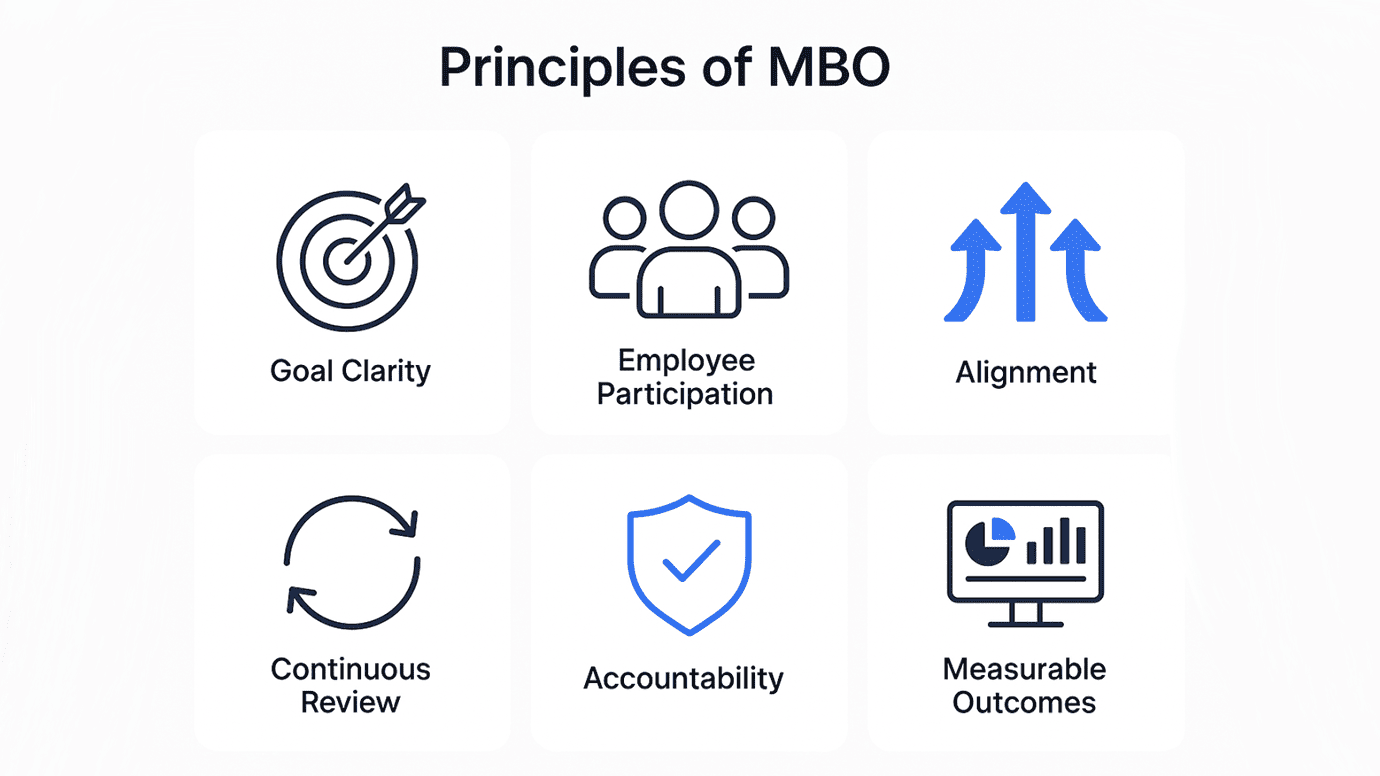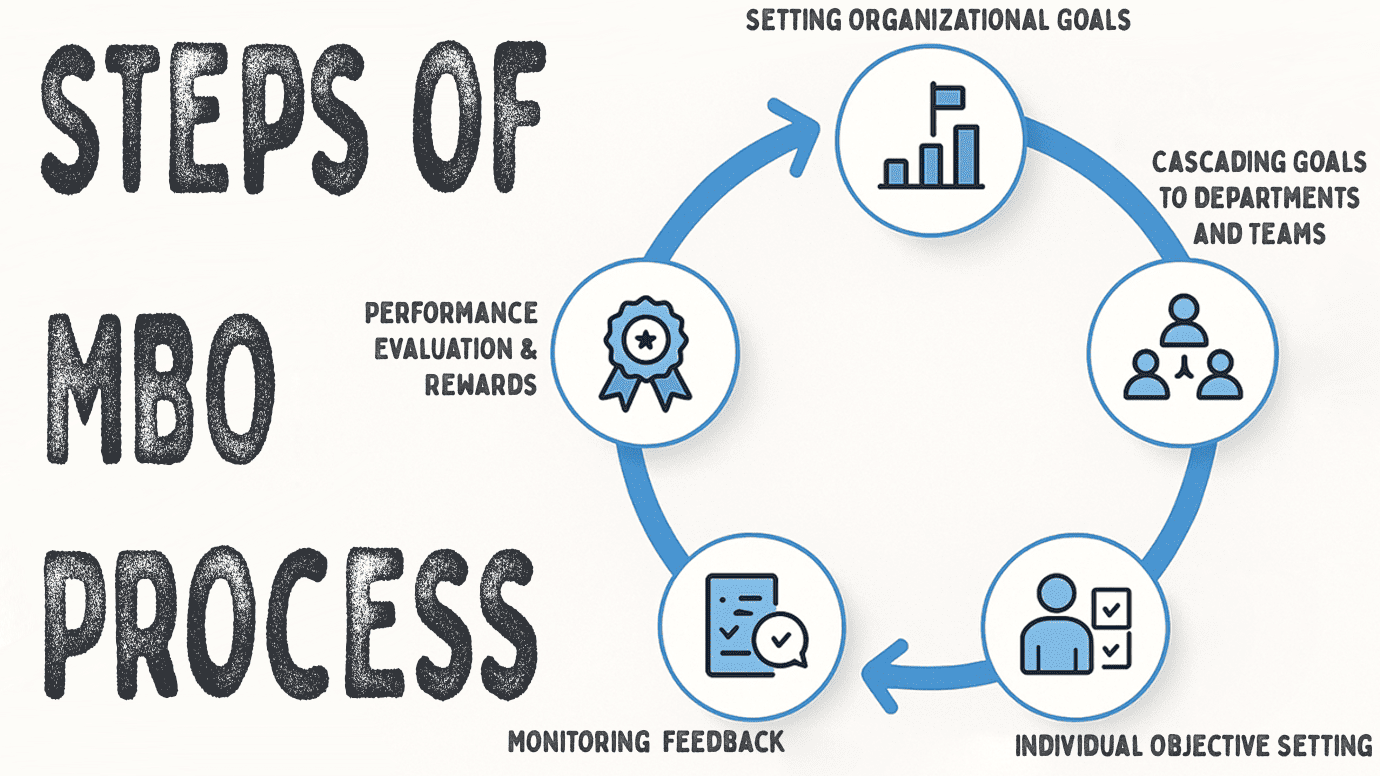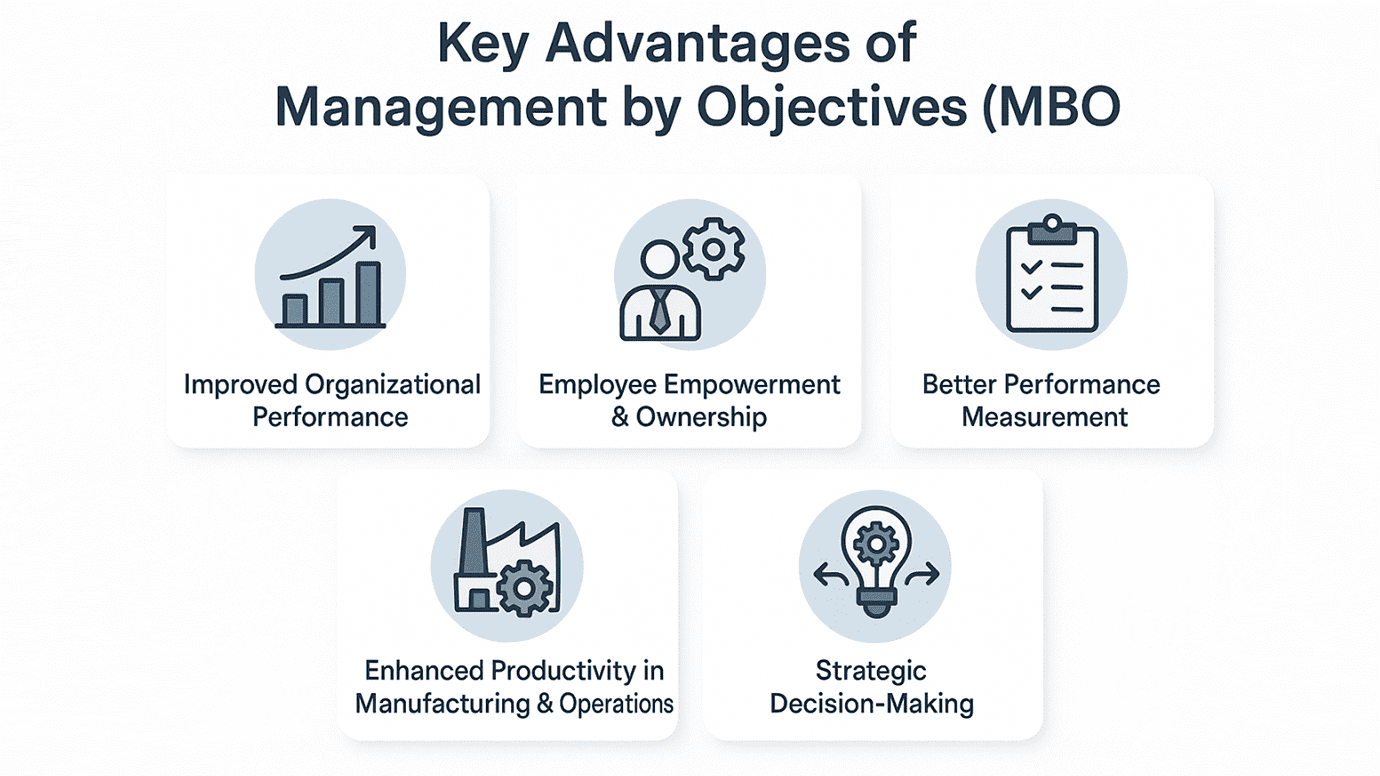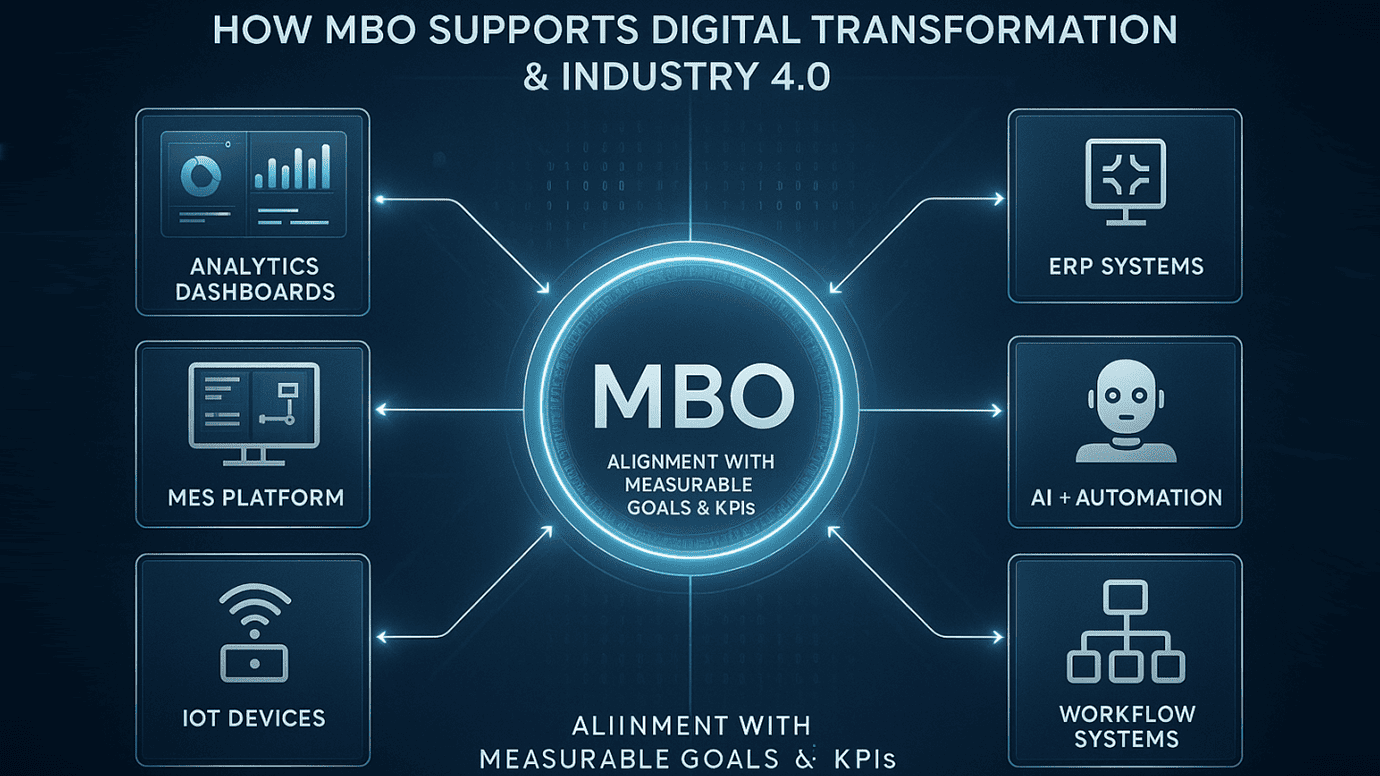Management by Objectives (MBO)
In today’s highly competitive business environment, organizations are under constant pressure
to deliver measurable performance, streamline processes, and build a culture of accountability. This is where bold MBO management—also known as management by objectives—has emerged as one of the most effective frameworks for driving clarity, alignment, and high performance across teams. At its core, the MBO concept revolves around setting clearly defined goals, aligning them with organizational priorities, and measuring results through a structured MBO process.
Modern companies—whether small and medium enterprises or large multinational corporations—are increasingly shifting towards objective-driven management because it ensures that everyone in the organization works with direction and purpose. The concept of management by objectives allows business leaders to translate strategy into actionable goals for every department, team, and individual. This approach enhances transparency, improves decision-making, and boosts employee engagement by making responsibilities measurable and meaningful.

For manufacturing units, supply chain operations, and corporate functions, the management by objectives process brings discipline and predictability into everyday operations. It helps identify productivity gaps, reduce wastage, streamline workflows, and create measurable KPIs. When applied correctly, the advantages of MBO include improved efficiency, better resource allocation, high-quality output, and faster execution cycles. This is especially valuable for factories adopting lean practices, logistics teams focused on precision, and corporate teams driving strategic growth.
As organizations look to transform and modernize, the principles of MBO play a critical role in building a performance-driven culture. The features of management by objectives—such as participative goal setting, continuous performance review, and measurable evaluation—make it a powerful tool for business transformation. Even the MBO appraisal method supports structured employee assessment tied directly to results. Ultimately, adopting MBO enables companies to convert vision into reality and move confidently toward sustainable growth.
Understanding MBO: Concept, History & Evolution
The foundation of bold MBO management lies in a simple yet powerful idea: organizations perform better when every goal is clearly defined, measurable, and aligned with strategic priorities. The concept of management by objectives refers to a collaborative goal-setting approach where managers and employees jointly define targets and evaluate outcomes through a structured MBO process. In essence, when you explain management by objectives, it is about transforming broad strategies into actionable objectives that guide day-to-day performance.

The MBO concept was introduced by Peter Drucker in the 1950s, marking a revolutionary shift in the management world. Drucker emphasized that the principles of MBO encourage participation, accountability, and transparent measurement—qualities that were missing in traditional management systems. Over time, the management by objectives process matured into a globally accepted performance model.
With the rise of Industry 4.0, automation, and digital workplaces, management by objectives has evolved dramatically. Today, real-time data, analytics dashboards, and integrated performance systems allow companies to execute the MBO process in management faster and more accurately. Technology enables precise tracking of KPIs, supports data-driven decision-making, and enhances the advantages of MBO by making progress visible across all levels of an organization.
Unlike traditional goal-setting, which often lacks clarity and accountability, the features of management by objectives ensure that objectives are specific, measurable, time-bound, and tied to organizational priorities. This not only strengthens the benefits of management by objectives but also enhances evaluation through tools such as the MBO appraisal method, ensuring performance is aligned with measurable outcomes.
Core Principles of MBO
The strength of bold MBO management lies in the solid foundation of its guiding principles. These principles of MBO ensure that organizations operate with clarity, structure, and measurable accountability. Understanding these core elements is essential for anyone looking to explain management by objectives effectively or implement a sustainable performance culture.

1. Goal Clarity
One of the most important principles of MBO is establishing precise and well-defined goals. Unlike vague targets in traditional management, the MBO concept focuses on objectives that are specific, achievable, and aligned with strategic priorities. Clear goals enable employees to focus efforts and understand what success looks like.
2. Participation of Employees in Objective Setting
A key differentiator of the concept of management by objectives is its participative nature. Employees actively contribute to setting their objectives, which increases ownership, engagement, and motivation. This collaborative approach enhances the benefits of management by objectives by building commitment across all levels.
3. Alignment of Individual & Organizational Goals
The management by objectives process ensures that individual targets connect directly to broader organizational goals. This alignment avoids duplication of efforts, promotes synergy among departments, and strengthens overall productivity. It is one of the core features of management by objectives that makes it effective.
4. Continuous Performance Review
In MBO management, goals are not set and forgotten. Regular reviews are an integral part of the MBO process in management, helping managers track progress, identify roadblocks, and implement corrective actions. This continuous loop ensures consistent performance improvement.
5. Accountability & Transparency in Roles
The MBO process promotes a culture where responsibilities are clearly defined. Each employee understands what they are accountable for, reducing confusion and improving efficiency. This clarity is one of the major advantages of MBO.
6. Focus on Measurable Outcomes
Finally, management by objectives emphasizes quantifiable performance. Whether through KPIs, dashboards, or the MBO appraisal method, measurable outcomes drive objective evaluation and unbiased decision-making.
The MBO Process: Step-by-Step Framework
The strength of bold MBO management lies in its structured and systematic approach to setting and achieving meaningful objectives. The MBO process follows a clear framework that empowers organizations to convert strategy into measurable action. This step-by-step process ensures alignment, accountability, and performance improvement across every level of the organization. Below is a detailed breakdown of each stage within the MBO process in management.

1. Setting Organizational Goals
- The first step of the concept of management by objectives is establishing clear, well-defined strategic goals. These high-level objectives reflect the company’s long-term vision, market positioning, and competitive strategy. Strategic goals may include expanding into new markets, improving customer satisfaction, or strengthening operational efficiency.
- Once strategic goals are framed, they are broken down into market, financial, and operational goals. For example, a company may aim to increase market share by 10%, improve profitability by reducing production costs, or enhance operational efficiency through automation. These clear targets demonstrate one of the major features of management by objectives—goal clarity and strategic alignment.
2. Cascading Goals to Departments and Teams
- A vital characteristic of the MBO concept is the cascading of organizational goals into departmental and team objectives. Each function—factory operations, HR, finance, sales, supply chain, and administration—receives a set of targets aligned with the strategic direction.
- For instance, if the company aims to improve manufacturing output by 15%, factory operations may focus on reducing downtime, improving OEE, or enhancing workforce productivity. HR may focus on skill training, finance may optimize cost structures, and sales may strengthen demand forecasting. This alignment highlights the advantages of management by objectives by ensuring cross-functional cohesion and eliminating operational silos.
3. Individual Objective Setting
- The next step in the management by objectives principles involves translating departmental goals into individual objectives. Here, employees help define their own goals using the SMART approach—Specific, Measurable, Achievable, Relevant, and Time-bound.
- A machinist may aim to maintain machine uptime at 98%, while a sales executive may work toward generating 20 new leads per month. These objectives are then linked to KPI-based measurement, promoting transparency and accountability. This stage reinforces the advantages of MBO by increasing employee engagement and ownership.
4. Monitoring, Feedback & Mid-Cycle Review
- The MBO process in management places a strong emphasis on continuous monitoring and structured feedback. Monthly or quarterly review meetings help managers assess progress, identify challenges, and revise the plan when required.
- Data-driven insights—powered by dashboards, ERP systems, or performance analytics—help ensure accurate, real-time tracking of KPIs. This ongoing evaluation enhances the advantages of management by objectives by making decision-making more timely and evidence-based.
5. Performance Evaluation & Rewards
- In the final stage of the MBO process, performance is evaluated against measurable outcomes. This evaluation is often supported by the MBO appraisal method, which ensures fairness and objectivity.
- When targets are met, rewards such as bonuses, recognition, promotions, or career progression may be provided. Connecting goals with incentives strengthens motivation and reinforces the principles of MBO. This structured evaluation system ensures that employees are recognized for measurable contributions rather than subjective assessments.
Advantages of MBO for Organizations
The adoption of bold MBO management brings transformative value to organizations across industries. By introducing structure, clarity, and alignment, the concept of management by objectives reshapes how businesses approach performance. The following sections break down the key benefits of management by objectives, especially for modern companies striving for operational excellence, improved productivity, and competitive growth.

1. Improved Organizational Performance
- One of the most significant advantages of MBO is the improvement in overall organizational performance. Because the management by objectives process begins with clear and measurable goals, it eliminates confusion and removes ambiguity in expectations. Everyone—from senior leaders to ground-level employees—knows exactly what is expected from them.
- Moreover, better coordination is achieved across departments as goals are aligned vertically and horizontally. This structured alignment, a hallmark of the features of management by objectives, ensures that teams collaborate effectively instead of working in isolated silos. The result is smoother operations, clearer communication, and unified efforts toward shared organizational outcomes.
2. Employee Empowerment & Ownership
- A unique strength of the MBO concept lies in its participative nature. When employees actively contribute to goal-setting, they experience increased motivation and stronger emotional commitment to their responsibilities. This employee empowerment fosters a sense of ownership, making them more accountable and engaged.
- By encouraging participation in decision-making, the management by objectives principles create a culture of transparency and trust. This leads to higher job satisfaction, reduced resistance to change, and a more collaborative work environment.
3. Better Performance Measurement
- With the MBO process, organizations shift from subjective evaluations to quantifiable results. Because goals are measurable and aligned with KPIs, both managers and employees can objectively track progress. This clarity strengthens fairness in evaluation, especially when using tools such as the MBO appraisal method.
- Additionally, digital tools used in the MBO process in management provide real-time performance tracking, enabling leaders to make quick and informed decisions. As a result, inefficiencies are spotted early, corrective actions are taken faster, and overall business agility improves.
4. Enhanced Productivity in Manufacturing & Operations
- The benefits of management by objectives are particularly visible in manufacturing and operational environments. Clear goal alignment across factory operations, maintenance, supply chain, and quality teams enhances workflow efficiency.
- For example, if the objective is to improve supply chain efficiency by 20%, the multi-department alignment ensures that procurement, logistics, production planning, and warehouse teams work collaboratively. This integrated approach leads to reduced delays, optimized inventory levels, and enhanced throughput—clear indicators of improved operational productivity.
5. Strategic Decision-Making Made Easier
- Finally, the management by objectives process gives leaders reliable data and structured insights for better decision-making. Because performance is linked to measurable outcomes, managerial decisions become more accurate, timely, and strategy-driven.
- The principles of MBO help senior management evaluate what is working, identify what needs improvement, and prioritize initiatives that drive the highest value. This elevates the organization’s ability to respond to market changes, plan future growth, and sustain long-term competitiveness.
Challenges in Implementing MBO & How to Overcome Them
While bold MBO management is widely recognized for improving performance and accountability, organizations often encounter challenges when implementing the system. The management by objectives process requires structured planning, transparent communication, and strong leadership support. When these elements are missing, the benefits of management by objectives are weakened, and the system may fail to deliver its intended impact. Below are the most common obstacles companies face and practical ways to overcome them.

Too Many Goals
One of the most frequent issues in implementing the MBO concept is setting an excessive number of goals. When there are too many objectives, employees lose focus and become overwhelmed. This dilutes efforts and leads to poor execution.
- Solution: Organizations should prioritize goals using the core principles of MBO, focusing on high-impact objectives that directly support strategic outcomes. Limiting goals ensures better clarity, alignment, and performance.
Poor Communication between Management & Employees
Clear communication is a non-negotiable requirement in the management by objectives process. When managers fail to articulate expectations, timelines, or KPI parameters, misunderstandings arise and objectives become misaligned.
- Solution: Implement open communication channels, structured discussions, and consistent updates. Transparent dialogue reinforces the features of management by objectives, ensuring everyone understands the direction and expectations.
Lack of Training
Employees and managers may struggle with the MBO process if they are not trained in goal-setting, performance measurement, or using digital tracking tools.
- Solution: Provide comprehensive training on how to explain management by objectives, set SMART goals, and track KPIs. Training boosts confidence and increases the overall effectiveness of the MBO process in management.
Rigid Organizational Structures
A rigid hierarchy can create barriers in adopting the concept of management by objectives. When decision-making is centralized and employees have little autonomy, they cannot fully participate in setting their goals.
- Solution: Promote a flexible, collaborative environment that empowers employees. The participative nature of management by objectives principles encourages involvement and motivates employees to contribute meaningfully.
Insufficient Review Mechanism
Without regular reviews, the advantages of MBO diminish. Some organizations set goals annually and fail to monitor progress, leading to delays, confusion, and missed targets.
- Solution: Establish structured monthly or quarterly review meetings. Use analytics dashboards, performance reports, and digital tools to track real-time progress. This also strengthens the fairness of the MBO appraisal method.
Misalignment between Ground Reality & Strategic Goals
Sometimes strategic goals do not reflect the practical realities faced by employees or specific departments. This misalignment creates frustration and reduces motivation.
- Solution: Encourage bottom-up feedback during the goal-setting stage. The features of management by objectives emphasize alignment; therefore, goals must be practical, achievable and relevant to the actual operating environment.
Implementing management by objectives successfully requires consistency, clarity, and collaboration. When these challenges are addressed proactively, organizations experience the full benefits of management by objectives, leading to improved performance, employee engagement, and long-term business growth.
How MBO Supports Digital Transformation & Industry 4.0
Digital transformation and Industry 4.0 have shifted organizations toward data-driven decision-making, automation, and smarter operations. In this evolving environment, bold MBO management plays a crucial role by aligning digital tools with clear, measurable objectives. Below is how the concept of management by objectives strengthens digital transformation initiatives.

Real-Time Dashboards for Instant Visibility
- Modern organizations use analytics dashboards and IoT-driven systems that display real-time operational data.
- When integrated with the management by objectives process, these dashboards allow managers to:
- Track KPIs instantly
- Monitor productivity, downtime, and output in real time
- Make faster and more informed decisions
- This enhances the benefits of management by objectives by enabling continuous improvement through accurate data visibility.
ERP & MES-Based Tracking for Precision Monitoring
- ERP systems capture financial, supply chain, HR, and operational data.
- MES platforms track machine-level efficiency, production cycles, and quality metrics.
- Linking these systems with the MBO process ensures:
- Precise goal tracking
- Automated reporting
- Early detection of deviations
- This deep integration is one of the most impactful features of management by objectives in Industry 4.0.
Improved Performance Transparency across the Organization
- Digital transformation demands visibility and accountability at all levels.
- The MBO process in management naturally supports this by:
- Providing clarity on goals, KPIs, and responsibilities
- Allowing employees to view their progress at any time
- Encouraging a culture of transparency and ownership
- This aligns with core management by objectives principles and strengthens teamwork.
Linking Digital Tools to Measurable Objectives
- AI, automation, workflow systems, and digital analytics are powerful—but only when tied to clear goals.
- Management by objectives ensures that every digital capability supports a measurable target.
- This leads to:
- Better decision-making
- Enhanced operational efficiency
- Maximum utilization of digital investments
- Evaluation through the MBO appraisal method ensures fair and performance-based assessment.
Strong Alignment between Strategy & Technology
- Industry 4.0 initiatives often fail due to poor alignment with organizational goals.
- The MBO concept eliminates this risk by ensuring technology adoption aligns with strategic outcomes.
- This strengthens long-term digital transformation and boosts the advantages of MBO across all departments.
Also Read: Industry 5.0
FAQs
A. MBO, or management by objectives, is a performance strategy where managers and employees work together to define clear, measurable goals.
A. The MBO process is important because it provides clarity, direction, and transparency. It aligns individual goals with organizational strategy, allowing teams to work cohesively. The benefits of management by objectives include better communication, higher productivity, and improved performance measurement.
A. The main management by objectives principles include clear goal-setting, participative decision-making, alignment of goals, continuous performance review, and measurable outcomes. These principles of MBO ensure that objectives are realistic, relevant, and aligned with company priorities.
A. Key advantages of MBO include improved coordination, employee empowerment, data-driven decisions, and measurable performance tracking. The features of management by objectives help organizations streamline processes and maintain accountability at all levels.
A. The MBO appraisal method evaluates employee performance based on how well they achieve pre-defined objectives. Unlike subjective reviews, this approach relies on measurable outcomes, making evaluations fair, transparent, and aligned with the management by objectives process.
A. Traditional systems often set goals top-down without clear measurement. In contrast, the MBO concept emphasizes participative goal-setting, clear KPIs, and regular reviews. This makes the concept of management by objectives more effective for modern, dynamic workplaces.
A. MBO supports Industry 4.0 by linking digital tools with measurable objectives. Real-time dashboards, ERP/MES systems, and data-driven insights enhance the MBO process in management, enabling precise tracking, transparency, and faster decision-making.
A. Yes, The management by objectives process is highly effective in manufacturing and supply chain environments. It helps define production targets, improve efficiency, reduce wastage, and align multi-department teams—leading to strong benefits of management by objectives for operational excellence.
Conclusion
In an increasingly competitive and fast-evolving business landscape, organizations need a structured and reliable approach to improve performance and achieve sustainable growth. This is exactly where bold MBO management proves its value. The concept of management by objectives provides a clear and strategic framework that aligns individual efforts with organizational priorities, ensuring every employee understands their role in the company’s success. By helping leaders explain management by objectives through measurable goals and transparent performance systems, MBO builds clarity and purpose across all functions.
One of the most compelling strengths of the MBO concept is its ability to transform business performance. Through a structured management by objectives process, companies eliminate ambiguity, strengthen accountability, and foster a culture of ownership. Whether improving manufacturing efficiency, enhancing financial control, or optimizing team productivity, the MBO process in management ensures that every objective is measurable, actionable, and aligned with long-term strategy. Tools like the MBO appraisal method further enhance fairness and objectivity in performance evaluation.
The advantages of MBO extend beyond better goal-setting—they promote transparency, encourage collaboration, and enable data-driven decision-making. The core management by objectives principles, such as participative goal-setting and continuous review, help businesses stay agile and responsive to market demands. These features of management by objectives empower organizations to monitor progress in real time and correct course when necessary, resulting in improved outcomes and stronger growth.
As businesses navigate digital transformation, global competition, and operational complexity, adopting a structured and disciplined approach like MBO becomes essential. The long-term benefits of management by objectives make it clear: companies that embrace MBO are better equipped to achieve higher productivity, stronger employee engagement, and sustained organizational excellence.
For more information, go to our Homepage.

